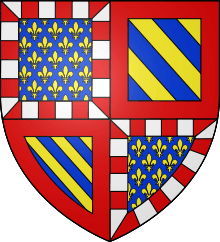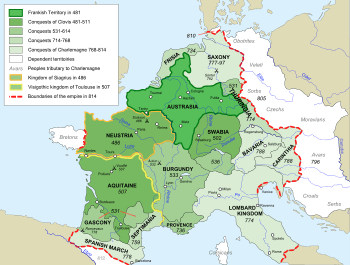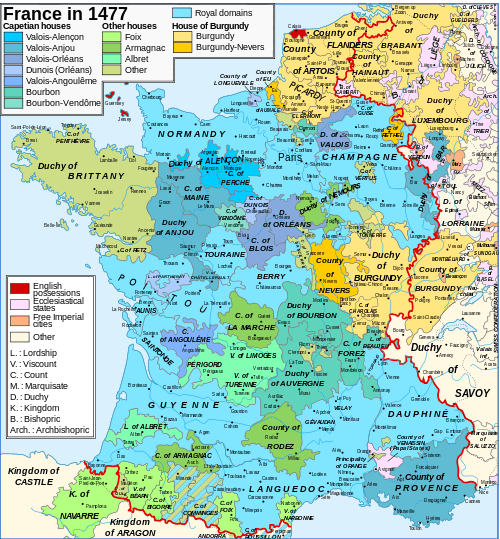History of Burgundy


The History of Burgundy stretches back to the times when the region was inhabited in turn by Celts, Romans (Gallo-Romans), and in the 4th century, the Roman allies the Burgundians, a Germanic people possibly originating in Bornholm (Baltic Sea), who settled there and established their own kingdom. However, Agathias identifies Burgunds (Βουρουγουνδοι) and Ultizurs as Bulgaric people of Hunnic circle tribes, near relatives of Turkic Cotrigurs and Utigurs.[1][2] This Burgundian kingdom was conquered in the 6th century by another Germanic tribe, the Franks who continued the kingdom of Burgundy under their own rule.
Later, the region was divided between the Duchy of Burgundy (to the west) and the County of Burgundy (to the east). The Duchy of Burgundy is the better-known of the two, later becoming the French province of Burgundy, while the County of Burgundy became the French province of Franche-Comté, literally meaning free county.
The situation is complicated by the fact that at different times and under different geopolitical circumstances, many different entities have gone by the name of ‘Burgundy’. Historian Norman Davies has commented that "[f]ew subjects in European history have created more havoc than that summarized by the phrase ‘all the Burgundies’." In 1862, James Bryce compiled a list of ten such entities, a list which Davies himself extends to fifteen, ranging from the first Burgundian kingdom founded by Gunther in the fifth century, to the modern French région of Burgundy.[3]
The Burgundians were one of the Germanic or Turko-Germanic alliance peoples who filled the power vacuum left by the collapse of the western half of the Roman Empire. In A.D. 411, they crossed the Rhine and established a kingdom at Worms. Amidst repeated clashes between the Romans and Huns, the Burgundian kingdom eventually occupied what is today the borderlands between Switzerland, France, and Italy. In 534, the Franks defeated Godomar, the last Burgundian king, and absorbed the territory into their growing empire.
Burgundy's modern existence is rooted in the dissolution of the Frankish Empire. In the 880s, there were four Burgundies:
- the Kingdom of Upper (Transjurane) Burgundy around Lake Geneva,
- the Kingdom of Lower Burgundy in Provence,
- the Duchy of Burgundy west of the Saône,
- the County of Burgundy east of the Saône.
The two kingdoms of Upper and Lower Burgundy were reunited in 937 and absorbed into the Holy Roman Empire under Conrad II in 1032, as the Kingdom of Arles. The Duchy of Burgundy was annexed by the French throne in 1004. The County of Burgundy remained loosely associated with the Holy Roman Empire (intermittently independent, whence the name "Franche-Comté"), and finally incorporated into France in 1678, with the Treaties of Nijmegen.
During the Middle Ages, Burgundy was the seat of some of the most important Western churches and monasteries, among them Cluny, Cîteaux, and Vézelay.


During the Hundred Years' War, King John II of France gave the duchy to his youngest son, Philip the Bold, rather than leaving it for his successor on the French throne. The duchy soon became a major rival to the throne, because the Dukes of Burgundy succeeded in assembling an empire stretching from Switzerland to the North Sea, in large part by marriage. The Burgundian territories consisted of a number of fiefdoms on both sides of the (then largely symbolic) border between the Kingdom of France and the Holy Roman Empire. Its economic heartland was in the Low Countries, particularly Flanders and Brabant. The court in Dijon outshone the French court both economically and culturally. In Belgium and in the south of the Netherlands, a 'Burgundian lifestyle' still means 'enjoyment of life, good food, and extravagant spectacle'.
In 1477, at the battle of Nancy during the Burgundian Wars, the last duke Charles the Bold was killed in battle, and the Duchy itself was annexed by France. In the late 15th and early 16th centuries, the other Burgundian territories provided a power base for the rise of the Habsburgs, after Maximilian of Austria married the surviving daughter of the ducal family, Mary. After her death, her husband moved his court first to Mechelen and later to the palace at Coudenberg, Brussels, and from there ruled the remnants of the empire, the Low Countries (Burgundian Netherlands) and Franche-Comté, then still an imperial fief. The latter territory was ceded to France in the Treaty of Nijmegen of 1678.
With the French Revolution in the end of the 18th century, the administrative units of the regions disappeared, but were reconstituted during the Fifth Republic in the 1970s. The modern-day administrative région includes most of the former duchy.
See also
- Burgundian Netherlands
- Count of Burgundy
- County of Burgundy
- Duchy of Burgundy
- Duke of Burgundy
- French wine
- Kingdom of Burgundy
- King of Burgundy
- House of Burgundy
References
- ↑ Agathias, Histiriae, V,11,3-4
- ↑ Runciman S., A history of the First Bulgarian empire, London, G.Bell & Sons, 1930, p.7, & notes
- ↑ Norman Davies, Vanished Kingdoms, 2011, Penguin (2012) pp. 90-143.
External links
| Wikisource has the text of the 1911 Encyclopædia Britannica article Burgundy. |
- (English) Burgundy at DMOZ
- Burgundy in the 1913 Catholic Encyclopedia at BibleWiki
- Burgundy in the 1913 Catholic Encyclopedia at NewAdvent.org
- (English) (French) Burgundy Tourism
- Départements, arrondissements & cantons of Burgundy (INSEE site)
- (French) Netbourgogne, site sur la Bourgogne